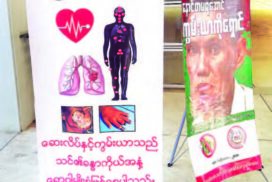The number of deaths caused by cancer, hypertension, and respiratory diseases would be higher in the coming years if the current levels of consumption of tobacco products, including betel quid and cigarettes, do not reduce.
Smoking and consumption of tobacco products kill more than 60,000 people every year in Myanmar. Tobacco products, including cigarettes, can cause at least 16 different cancers of the body, including lung cancer, cancers of the mouth, larynx, pharynx, oesophagus, bladder, kidney, pancreas, liver, cervix, stomach, colon, and rectum. On average, people who smoke die about 10 years earlier than people who have never smoked.
Tobacco products consumption, including smoking, is the most preventable cause of premature death in our country. The time comes now to enforce rules on smoking and consumption of tobacco products.
To improve the effectiveness of the policy on tobacco use, crowded places nationwide should establish no smoking and betel quid chewing zones. Meanwhile, we should not underestimate the risk associated with e-cigarettes and vaping devices, which are popular among teens today.
The designation of smoke-free areas creates a healthier environment, makes travel to that particular destination more attractive, and reduces damage to heritage sites and the risk of stray fires.
It took researchers at least 50 years to understand that cigarettes cut the lifespan of smokers by 10 years.
Tobacco products consumption, including smoking, is the most preventable cause of premature death in our country.
Every year, more than 8 million people die from tobacco use, according to data from the World Health Organization. More than 7 million of those deaths are from direct tobacco use, while around 1.2 million are due to exposure to second-hand smoke.
Tobacco products, including cigarettes, can cause at least 16 different cancers of the body, including lung cancer, cancers of the mouth, larynx, pharynx, oesophagus, bladder, kidney, pancreas, liver, cervix, stomach, colon, and rectum.
According to a survey conducted by the WHO in 2014, the prevalence of risk factors for contracting non-communicable diseases was one for 94 per cent of the people and three to five for about 19.6 per cent of the people.
To make the tobacco-free policy — which is a good measure to improve people’s health — realistic, we also need to impose fines on businesses that sell tobacco products to kids and in restricted areas.
Most important, we need to make young people understand how incredibly foolhardy it is to inhale and swallow chemicals whose effects we do not understand and which lead to an addiction many cannot escape.














